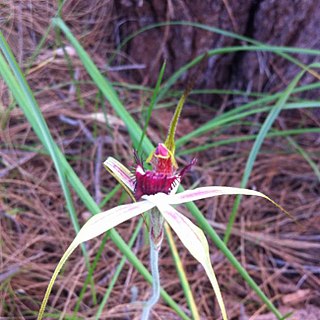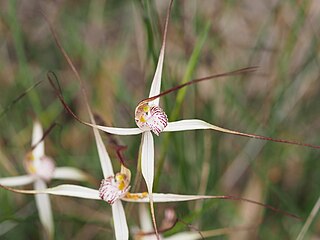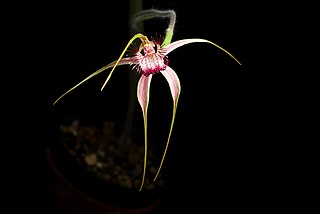
Caladenia paludosa, commonly known as the swamp spider orchid, is a species of orchid endemic to the south-west of Western Australia. It has a single erect, hairy leaf and up to three red, greenish-yellow and cream-coloured flowers. It mostly grows in dense scrub and is one of the last of the similar spider orchids to flower.

Caladenia cruscula, commonly known as the reclining spider orchid is a species of orchid endemic to a small area in the south-west of Western Australia. It has a single hairy leaf and a single cream-coloured flower with a long red fringe on the sides of its labellum.

Caladenia ensata, commonly known as the stumpy spider orchid, is a species of orchid endemic to the south-west of Western Australia. It is a common orchid within its natural range and has a single, hairy leaf and up to three pale yellow and red flowers which have short but thick, fleshy glandular tips.
Caladenia erythronema, commonly known as the red thread spider orchid, and Nyabing spider orchid is a plant in the orchid family Orchidaceae and is endemic to the south-west of Western Australia. It has a single hairy leaf and up to three red, yellow or cream-coloured flowers with dangling, thread-like sepals and petals and a small labellum.
Caladenia evanescens, commonly known as the semaphore spider orchid, is a species of orchid endemic to a small area near Albany in the south-west of Western Australia. It is a rare species with a single, hairy leaf and one or two cream-coloured to greenish-cream flowers.

Caladenia excelsa, commonly known as the giant spider orchid, is a species of orchid endemic to a small area in the south-west of Western Australia. It is a rare species with a single, hairy leaf and up to three cream-coloured to greenish-cream flowers with long, drooping sepals and petals. It is one of the tallest spider orchids in Western Australia and, with Caladenia splendens, has the largest flowers of any Western Australian orchid.
Caladenia exilis subsp. vanleeuwenii, commonly known as the Moora spider orchid, is a plant in the orchid family Orchidaceae and is endemic to the south-west of Western Australia. It is a relatively rare spider orchid with a single erect, hairy leaf and up to three variably-coloured flowers with a small white, red-striped labellum. It differes from subspecies exilis in having variably coloured flowers, different growth habit, earlier flowering and different habitat.
Caladenia harringtoniae, commonly known as the pink spider orchid, is a species of orchid endemic to the south-west of Western Australia. It has a single, hairy leaf and up to three pale to deep pink flowers which have a cream-coloured labellum with a pink tip.
Caladenia hiemalis, commonly known as the dwarf common spider orchid is a species of orchid endemic to the south-west of Western Australia. It has a single, hairy leaf and one or two, cream-coloured flowers with a small, red-striped labellum. It has an early flowering period and its flowering is stimulated by summer fires.
Caladenia hoffmanii, commonly known as Hoffman's spider orchid is a species of orchid endemic to the south-west of Western Australia. It has a single, hairy leaf and one or two, greenish-yellow, red and white flowers which have a greenish-yellow labellum with a red tip. It is distinguished from the Pingaring spider orchid by small differences in the labellum and more northerly distribution.

Caladenia horistes, commonly known as the cream spider orchid is a species of orchid endemic to the south-west of Western Australia. It has a single, hairy leaf and one or two, creamy-yellow flowers which have a red-striped labellum and long, dark, thread-like tips on the sepals and petals.
Caladenia luteola, commonly known as the lemon spider orchid, is a species of orchid endemic to the south-west of Western Australia. It has a single, hairy leaf and up to three lemon-yellow flowers with red stripes on the labellum. It is only known from two small populations near Woodanilling.

Caladenia microchila, commonly known as the western wispy spider orchid, is a species of orchid endemic to the south-west of Western Australia. It is relatively common orchid with a single erect, hairy leaf and up to three wispy white flowers with narrow lateral sepals and petals and a white labellum with red markings.

Caladenia multiclavia, commonly known as the lazy spider orchid is a species of orchid, endemic to the south-west of Western Australia. It has a single, hairy leaf and one or two greenish-yellow, red and cream-coloured flowers resembling a reclining spider. Although it usually only has a single flower, it often grows in clumps of up to six plants.
Caladenia nobilis, commonly known as the noble spider orchid, is a species of orchid endemic to the south-west of Western Australia. It has a single hairy leaf and one or two large white flowers with a red-marked labellum.

Caladenia pendens subsp. talbotii, commonly known as Talbot's spider orchid, is a plant in the orchid family Orchidaceae and is endemic to the south-west of Western Australia. It has a single hairy leaf and one or two white, red and yellow flowers with long drooping petals and sepals and sometimes has a citrus-like scent.
Caladenia pholcoidea subsp. augustensis, commonly known as the Augustus spider orchid, is a plant in the orchid family Orchidaceae and is endemic to the south-west of Western Australia. It is a rare orchid with a single hairy leaf and up to three mostly white flowers with long spreading petals and lateral sepals.

Caladenia polychroma, commonly known as the Joseph's spider orchid, is a species of orchid endemic to the south-west of Western Australia. It has a single erect, hairy leaf and one or two relatively large and colourful but smelly flowers.

Caladenia serotina, commonly known as the Christmas spider orchid, is a species of orchid endemic to the south-west of Western Australia. It has a single erect, hairy leaf and up to three white to cream-coloured and red flowers, although the relative amount of each is variable. It is one of the later-flowering spider orchids and occurs in the far south-west corner of the state.
Caladenia xantha, commonly known as the primrose spider orchid, is a species of orchid endemic to the south-west of Western Australia. It has a single erect, hairy leaf and up to three yellow flowers with a cream-coloured, brown-striped labellum.



















